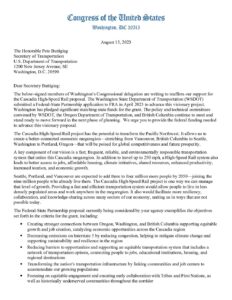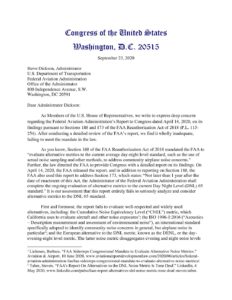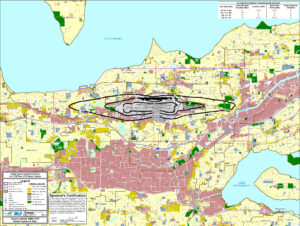The Ninth District is home to several airports, including Sea-Tac airport. Communities surrounding airports have come to experience an increased and disproportionate share of public health and environmental impacts stemming from increases in air traffic. Studies have demonstrated that communities near airports and airflight pathways are exposed to higher proportions of harmful pollution particles from
Washington State Congressional Delegation letter in support of Cascadia High Speed Rail proposal 08-15-2023

FAA needs to bring airport-affected communities to the table
By Adam Smith and Hamdi Mohamed Special to The Seattle Times For the first time in five years, Congress is working its way through the reauthorization process for the Federal Aviation Administration. It is imperative that Congress uses this opportunity to better incorporate the voices of communities affected by aviation in the federal aviation system.
Port Package Update Letter – Spring 2023
Greetings, As always, this is behind schedule. However, in addition to the the usual procrastination, things change all the time. Sorry, but for newcomers we always start with some background. If you’ve heard all this, just skip down… Your original Port Package was almost certainly financed through FAA funding called the Airport Improvement Program (AIP).
A letter to Representative Adam Smith: Conservation
Representative Smith, I had a conversation yesterday with your wonderful aide ███████████████████. I mentioned the idea of bringing ‘conservation’ into the discussion of air travel and she must have thought I was nuts. It is hard to explain to younger people how much Americans used to glamourise cars. The idea that we might ever feel
Adam Smith proposal for second chance sound insulation
A Letter To Congressman Adam Smith – AQM
The Sea-Tac Annual Air Quality Monitoring Program – a proposal Background Since 1971 there have roughly thirteen ‘studies’ of various air toxins around Sea-Tac Airport. We put the word ‘studies’ in air quotes because almost all of them have been limited either to a single toxin or to a subset of the complete Sea-Tac air
Beacon Hill Air & Noise Pollution Community Meeting Zoom Video
Congressional Quiet Skies Caucus Letter To FAA Administrator Steve Dickson re DNL65
Discussion:
 Currently, FAA law has extremely complicated rules for establishing a noise boundary around airports. (A noise boundary is a geographic area inside which there is ...
Currently, FAA law has extremely complicated rules for establishing a noise boundary around airports. (A noise boundary is a geographic area inside which there is ...
AICA Gone Local
For the past several years there has been a lot of energy directed at creating Federal legislation to correct the systemic unfairness we all experience living near a large airport like Sea-Tac. On the surface, this makes perfect sense: the FAA has direct authority over all airports. And many, many attempts at obtaining relief by
